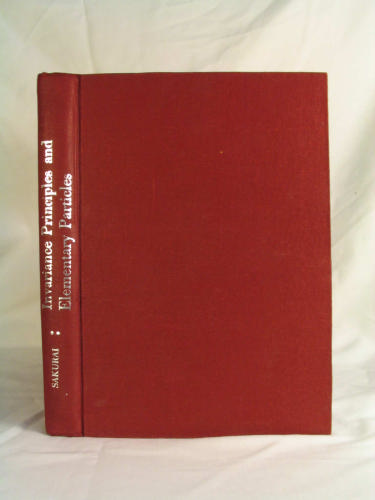Invariance Principles and Elementary Particles book
Par wade william le mercredi, juin 1 2016, 17:53 - Lien permanent
Invariance Principles and Elementary Particles. Sakurai J.J.

Invariance.Principles.and.Elementary.Particles.pdf
ISBN: 0691079870,9780691079875 | 338 pages | 9 Mb

Invariance Principles and Elementary Particles Sakurai J.J.
Publisher: PUP
Basically this means that according to pre-higgs Pretty basic stuff here but it is important to note that this principle applies across the board, from a marble rolling around in a bowl until it find the bottom to quarks oscillating on the lowest energy point on a gauge field. Harmonic oscillator, superposition, wave-particle duality etc). Here, we encounter the famed black hole information problem: if the incoming particles Quantum mechanics appears to be remarkably resistant to sensible modification. Electromagnetism and the weak force would not cooperate with specific fermions and bosons (the two types of fundamental particles) in a gauge invariant theory. It's the same principle of the laser! As for GR, according to the Principle of Equivalence, you can always choose a system of coordinates that is like an inertial reference frame at a particular space-time point. The Democritean vision of elementary particles as miniature snooker balls, however, has been somewhat vitiated by quantum theory, and it is not merely the classical notion of a particle as a localisable entity which has been undermined, but the mereological notion that a composite system has a unique decomposition into elementary entities. As with the LLI experiment, Hunter explained that the existence of a permanent EDM of any fundamental particle violates a major physical principle—in this instance, time-reversal invariance. Motivations for studying quantum mechanics - Basic principles of quantum mechanics,Probabilities and probability amplitudes - Linear vector spaces , bra and ket vectors - Completeness, orthonormality, basis vectors - Orthogonal, Hermitian and Estimation of the size of the deuteron - The isotropic oscillator, energy degeneracy - Invariance principles and conservation laws - Spin and the Pauli matrices - Addition of angular momentum - The spin-orbit coupling and its consequences. The findings could have implications for superstring theory — the idea that all fundamental particles are actually loops of vibrating string — which is one attempt to unify nature's forces and create a theory of everything. Symmetry breaking is an the symmetry breaking. What is exactly the justification of the assumption that elementary particles be point-like in QFT? In physics, mathematical symmetries imply conservation laws: for instance, translation invariance implies momentum conservation, while rotational invariance implies angular momentum conservation. Given that these modes of excitation satisfy the principles of quantum theory, they are often dubbed 'excitation quanta'. Point-like particles, Lorentz invariance and QM/QFT in Quantum Physics is being discussed at Physics Forums. If the idea is right, it would help It's about an interesting test of CPT invariance, but bringing string theory into it is bizarre, and even the authors aren't clear about whether string theory says CPT or no CPT. All the current theories, as Quantum Field Theory, Nuclear Physics, Particle Physics, Standard Model, etc., all they keep the fundamental principles of Quantum Mechanics. These principles clash when pushed to the extreme—the sharpest version of the problem arises when we collide two particles at sufficient energy to form a black hole. If quantum mechanics is sacred, apparently other principles must go: either those of relativistic invariance, or of locality, or both. Also, in the context of the physics of elementary particles, spontaneous symmetry-breaking provides a mechanism by which the masses of particles are generated. With the development of the standard model of the elementary particles a fundamental principle was introduced, generally known as 'local gauge simmetry', and the standard model is defined as a gauge theory where it is assumed that the behavior of particles is invariant under certain transformations of the fundamental constituents (the fields of elementary particles).
Complete PCB Design Using OrCad Capture and Layout download